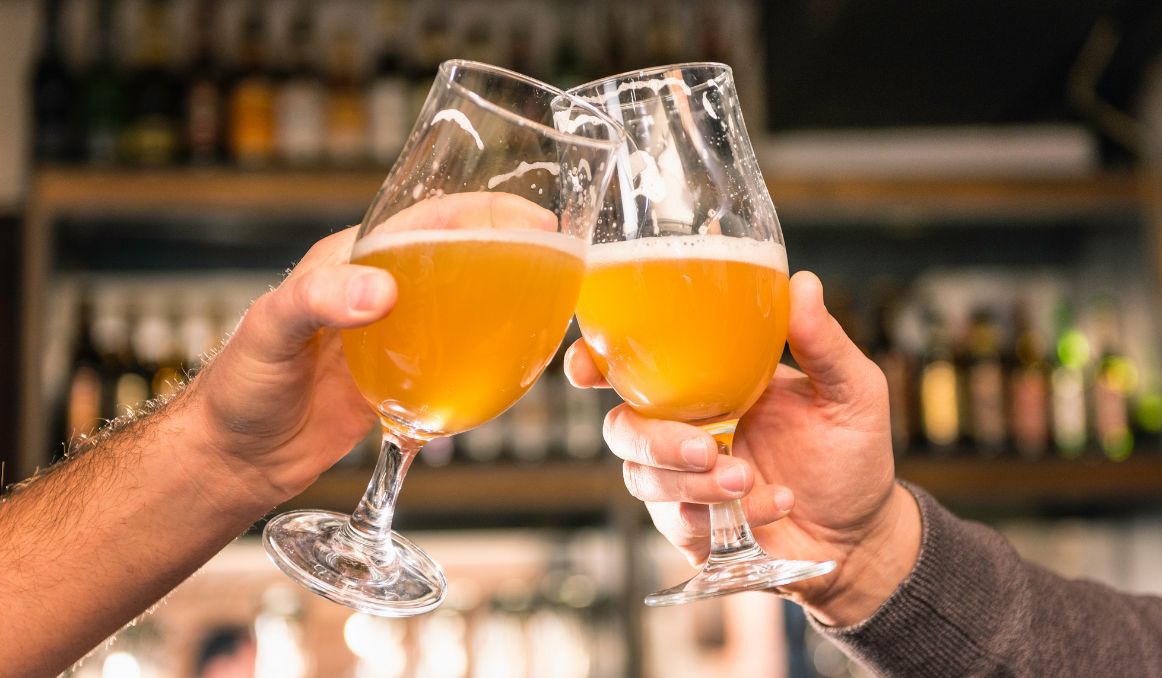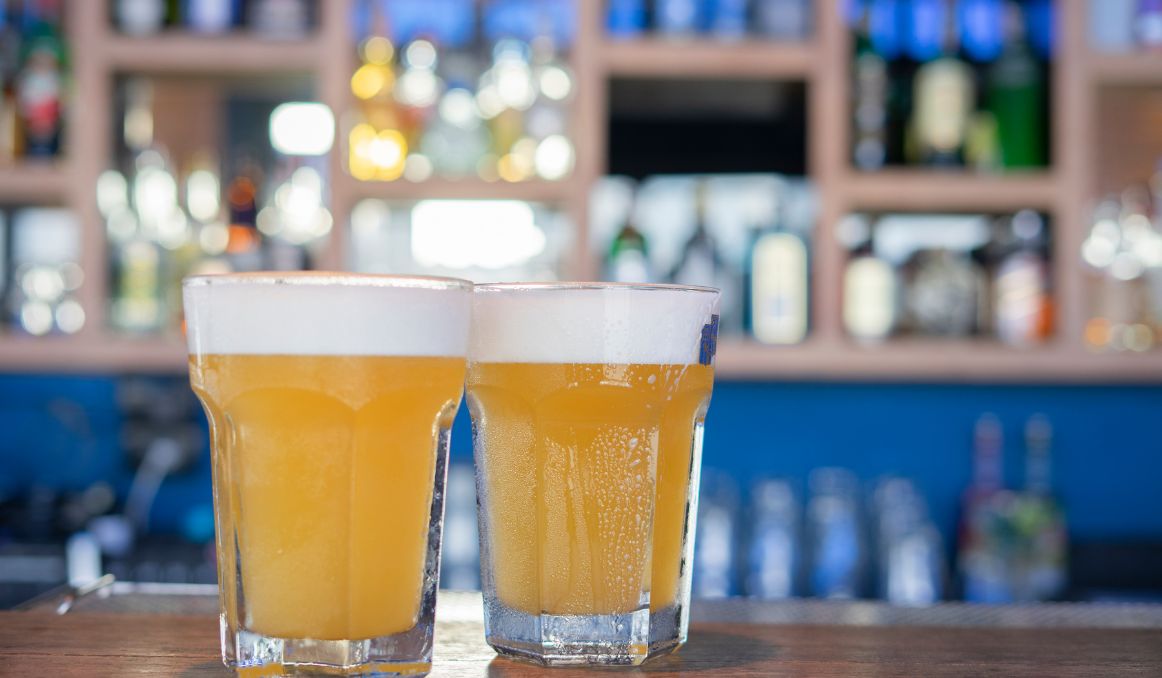All About Hazy Beer: Meaning and History
It’s funny to think about hazy beer: meaning and history. For decades, consumers expected a perfectly clear beer. Indeed, if a beer appeared hazy, people worried it was contaminated in some way, and some even claimed haze was harmful in beer!
Nothing could be further from the truth.
So what’s all the stink about? What is hazy beer? And do we like it or don’t we?
Hazy Beer: Meaning

Hazy beer is also referred to as turbid beer. Turbidity merely refers to the insoluble particles suspended in a beverage. You can see cloudiness when you look into the glass rather than a crystal clear liquid.
Today, when you think about hazy beer, the first thing that comes to mind is hazy IPA. Brewers in the last few decades have taken to not only allowing haze back into beer, but also stepping their haze game way up!
You can find beer so hazy, it’s practically thick with those suspended particles.
What Causes Haze?
So what are those suspended particles, anyway?
Haze can actually come from a variety of sources, from raw ingredients, to brewing style, but the two main contributors are the protein-polyphenol interaction and low flocculating yeast.
Proteins and Polyphenols
Of the two, the most common contributor by far to haze in beer is the protein-polyphenol interaction.
The basic ingredient in beer is usually either malted barley or wheat, both of which have high levels of protein in them, believe it or not. When brewers practice something known as “dry hopping,” which simply means the hops are added to the beer much later in the brewing process, the polyphenols from the hops combine with the protein from the grain, and they form a haze.
The more protein rich and hoppy a beer, the more haze you will get.
Low Flocculating Yeast
In wheat beers like Hefeweizen, there is an added reason for haze. The yeast used during fermentation is typically low flocculating yeast.
As most of you likely know, beer is made when a grain is malted, cracked, and then boiled and steeped in water. When the water, now referred to as wort, cools, yeast is added and fermentation begins.
Different strains of yeast ferment quite differently, and one of the many differences is flocculation.
There are high flocculating yeast strains and low flocculating yeast strains.
In high flocculating yeast strains, the yeast consume all the sugar in the wort, convert it to alcohol and carbon dioxide, and when they’re all tuckered out, they clump together and sit on top of the liquid or drop to the bottom to be filtered out and saved for another batch.
In low flocculating yeast strains, the yeast do not clump together. Rather, they hang, suspended, in the wort, causing that glorious golden haze so familiar to wheat beer drinkers.
The History of Hazy beer

It is important to note here that haze has always been around. It would never have occurred to brewers from thousands or even hundreds of years ago to filter haze out of their beer.
Indeed, remember that for hundreds of years people had no access to safe drinking water and instead served their entire families, from babies up to grandparents, a low alcohol beer.
The alcohol essentially removed anything worrisome from the water, and it was much more reliable as a means of hydration than river or creek water.
Additionally, because brewers did not even know what yeast was or the part it played in brewing, they certainly could not have selected for high or low flocculating yeast strains. They merely worked with what they had, the yeast in the beer would have been whatever local regional yeast was attracted to the barley or wheat wort.
Same goes for the haze that comes from the protein-polyphenol interaction. There was no expectation of filtered beer when people were merely thirsty for a nice cool ale.
The Rise of Industrialization and Clarity
It was only in the 1800s that Louis Pasteur figured out the role of yeast in beer, which happily coincided with the rise of industrialization in the world, which led to the rise of capitalism and corporate empires.
As corporate breweries began selecting “brewer’s yeasts,” and clean drinking water became a standard, a new expectation for clear and “clean” beer arose.
The standard was set. Suddenly clean and safe beer must be clear. And that standard stood, with the exception of wheat beers and lambics, for a century.
It has only been recently that brewers have reclaimed the haze, now adding in starches, extra sugar and yeast, and even more hops to get the haziest beer around.
No Harm. No Foul.
A critical factor in the discussion of hazy beer is that it is rarely, if ever harmful.
The medieval parents had it right: the alcohol content in beer very rarely allows anything harmful tot survive.
So while the wrong wild yeast strain may cause off flavors and aromas, or beer left in the sunlight might turn “skunky,” none of it will kill you or even make you sick.
You just won’t want to drink it. And who can blame you?
There are, of course, the rare exceptions where a bad batch of beer made some cows sick or gave someone a tummy ache, but those are few and far between.
The last thing you have to worry about at a bar or pub when you order a beer and find it hazy or cloudy is whether it will hurt you.
And if you’re a brewer, that is the least of your concerns.
Indeed, today’s brewers are much more concerned with maximizing on haziness and then getting a consistent haze every time.
Cheers!
Passionate about the beer and/or wine making process? So are we! If you’re interested in finding out how you can use our technology to control fermentation and monitor your yeast, save work hours and improve the cost-efficiency of your business, drop us a line at [email protected] or check out our product pages:
- Oculyze BB 2.0 (Better Brewing) Yeast Cell Counter App + Hardware
- Oculyze FW (Fermentation Wine) Yeast Cell Counter App + Hardware
Also, you can now get access to a fully functional demo account to test our Web App. Completely free of charge and with no commitment to purchase.
Sources:
- Yin Wang and Lingzhen Ye, Haze in Beer: Its Formation and Alleviating Strategies, from a Protein–Polyphenol Complex Angle, Foods 2021
- Karl J.Siebert, Chapter 2 Haze in Beverages, Advances in Food and Nutrition Research Volume 57, 2009, Pages 53-86
- https://www.allagash.com/blog/what-makes-beer-hazy/
- https://www.motherearthbrewco.com/post/what-s-makes-a-beer-hazy-the-answer-is-more-complicated-than-you-think


